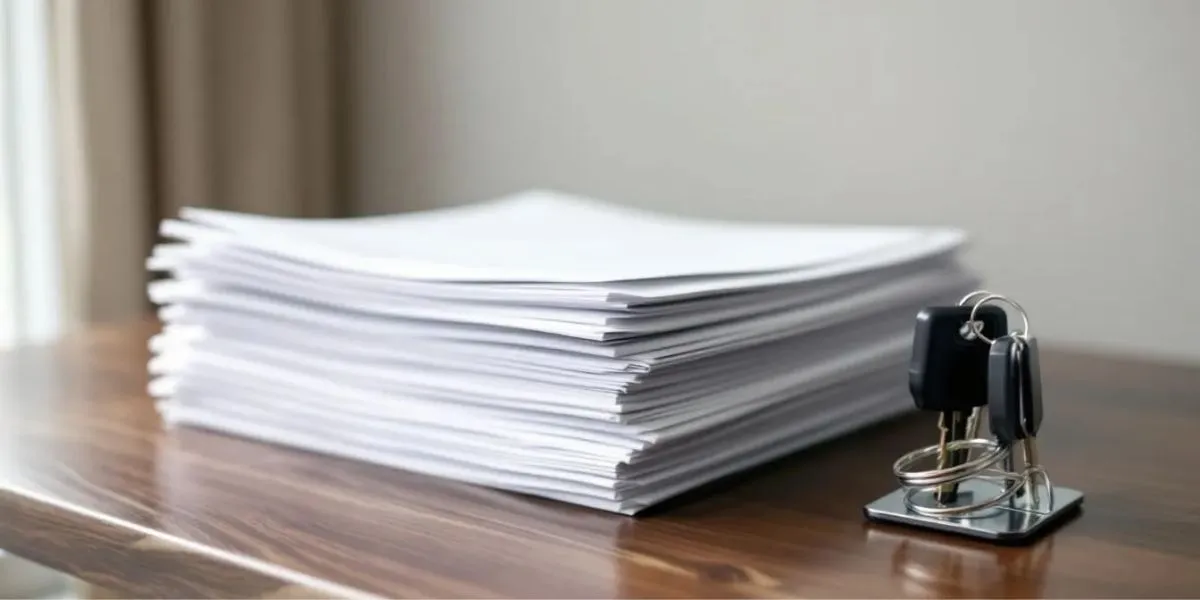Completing a property transaction marks an exciting milestone, but receiving the right documentation afterward is crucial for protecting your investment and legal rights. The buying process generates numerous essential documents that serve as proof of ownership, financial transparency, and legal compliance for years to come.
Understanding what documents should i receive after buying a house helps ensure you’re fully protected and prepared for future property transactions. This comprehensive guide breaks down every important document you should expect, organized by category and priority level. For a broader overview, see our house buying process guide.
Essential Documents You Should Receive Immediately
The most critical paperwork arrives shortly after completion, forming the foundation of your legal ownership and financial obligations.
Title Deeds and Land Registry Records
Your title deeds represent the core legal document proving property ownership. After completion, your conveyancing solicitor registers the title change with the land registry, establishing you as the registered proprietor. Most land registry records are now digital, with the official copy of the register serving as definitive proof of ownership.
The land registry typically processes new registrations within 2-3 months of completion, though new property developments may take longer due to volume and complexity. Your registered title will show any restrictions, mortgages, easements, and covenants affecting the property.
Stamp Duty Receipt
The stamp duty receipt confirms payment of Stamp Duty Land Tax (SDLT) to HMRC within the mandatory 30-day window following completion. This essential house purchase documents proves tax compliance and prevents future legal complications. Missing the SDLT deadline results in penalties and interest charges, making this receipt particularly important for your records.
Energy Performance Certificate (EPC)
Every property requires a valid energy performance certificate epc showing the property’s energy efficiency rating from A to G. Valid for ten years, this certificate has grown increasingly important as mortgage lenders and regulatory bodies focus on energy efficient properties. The EPC must be commissioned by a licensed assessor and covers insulation quality, heating systems, and overall design efficiency.
Property Information Form (TA6)
The property information form details crucial information about boundaries, utilities, planning permissions, and council tax bands. Completed by the previous owners before completion, this legal document provides ongoing ownership information and can be referenced for future disputes or queries about the property’s history.
Fittings and Contents Form (TA10)
The fittings and contents form creates a legally-binding inventory of fixtures, fittings, and contents included in the sale. This includes kitchen appliances, carpets, light fittings, and garden plants. The contents form prevents disputes about missing items between exchange and completion dates.

Legal and Ownership Documents
These documents establish and verify your legal title to the property, forming the backbone of your ownership rights.
Transfer Deed
The transfer deed serves as the principal legal document transferring ownership from seller to buyer. Usually completed on form TR1 or TP1, this document includes property descriptions, parties’ details, purchase price, and completion date. Without a properly executed transfer deed, legal title cannot pass to the new owner.
Your solicitor lodges the transfer deed with the land registry to complete the ownership transfer process. This document becomes part of the permanent title register for the property.
Copy of Registered Title
Within several weeks of completion, you’ll receive office copy entries from the land registry showing your name as the registered proprietor. For leasehold property or complex transactions, registration may take longer due to additional documentation requirements.
The registered title reveals important information about registered charges, rights of way, existing leases, and any ongoing disputes affecting the property.
Report on Title
Your conveyancing solicitor prepares a comprehensive report on title analyzing the property’s legal status. This important document summarizes findings from local authority search results, environmental searches, and title investigations. The report highlights any legal risks and ensures you understand all aspects of your property transaction before becoming contractually committed.
Solicitor’s Completion Statement
This detailed financial breakdown shows the purchase price, legal fees, search costs, stamp duty, and any adjustments for service charges or apportionments. Your completion statement serves as a closing account and provides essential reference information for tax queries or future audit requirements.
Mortgage and Financial Documents
If you’ve used mortgage financing, several additional documents detail your loan terms and financial obligations.
Mortgage Deed
The mortgage deed outlines your repayment schedule, interest rates, term length, and the mortgage lender’s rights in case of default. This legal document must be properly executed and registered with the land registry as a charge against the property title.
Understanding your mortgage deed terms helps ensure you meet all repayment obligations and understand your lender’s security interests in the property.
Completion Statement from Lender
Your mortgage lender provides a separate completion statement summarizing the loan amount, fees, and charges specific to your mortgage arrangement. This document helps clarify the exact funds drawn down and any additional costs associated with your loan.
SDLT Receipt Confirmation
Beyond your primary stamp duty receipt, mortgage transactions may generate additional SDLT documentation confirming the tax payable on the mortgage element of your transaction.
Bank Transfer Confirmations
Keep detailed records of all bank statement entries showing deposit transfers, completion payments, and mortgage fund releases. These serve as crucial evidence for anti-money laundering compliance and potential future disputes about payment timing or amounts.

Insurance and Protection Documents
Insurance documentation protects your investment and satisfies mortgage lender requirements.
Indemnity Insurance Certificate
Indemnity insurance covers specific legal defects that cannot be fully resolved during the conveyancing process. Common examples include missing planning permission, restrictive covenants, or chancel repair indemnity insurance. The indemnity insurance certificate details coverage scope, exclusions, and the insurer’s obligations.
Many conveyancing solicitors recommend purchase indemnity insurance as a pragmatic solution for managing title risks when complete documentation cannot be obtained.
Building Insurance Policy Documents
Building insurance becomes effective from your exchange date and covers the property’s reinstatement value. Your policy should include fire, flood, and accidental damage coverage appropriate to your property type and location. Mortgage lenders typically require comprehensive building insurance as a lending condition.
Annual premiums average £250-£350 for most UK properties, though costs vary significantly based on location, construction type, and coverage levels.
Home Warranty Documents
New builds and properties under ten years old often include home warranty coverage. The NHBC Buildmark warranty system covers approximately 80% of new UK builds, providing builder defect coverage for the first two years and insurance-backed structural protection for the remaining eight years.
NHBC Buildmark Protection
NHBC Buildmark represents the dominant warranty scheme for new property developments. This comprehensive protection gives homebuyers confidence in their purchase while satisfying mortgage lender requirements for new build financing.
Leasehold Property Specific Documents
Leasehold property purchases require additional documentation reflecting the complex relationship between leaseholder and freeholder.
Copy of the Lease Agreement
The lease agreement defines the legal relationship between leaseholder and freeholder, including term length, ground rent obligations, service charges, permitted uses, and forfeiture provisions. Understanding your lease terms is essential for ongoing compliance and future sale preparation.
Management Information Pack
The management pack provides recent and forecasted service charge accounts, planned major works, reserve fund status, and insurance arrangements. This leasehold information pack also includes correspondence about building repairs and any service charge schedule adjustments.
Most freeholders or managing agents charge fees for providing comprehensive management packs, but this information is crucial for understanding your ongoing financial obligations.
Share Certificate for Freehold Ownership
Properties with shared freehold ownership require share certificates evidencing your co-ownership interest in the freehold company. These certificates are particularly common in converted Victorian buildings where multiple leaseholders collectively own the freehold.
Building Insurance Details Arranged by Management
Leasehold property insurance is typically arranged by the freeholder or management company. You should receive annual insurance summaries showing the sum insured, provider details, and renewal dates as proof of adequate coverage.
Property Condition and Maintenance Records
Documentation about your property’s physical condition helps plan maintenance and supports future sale preparations.
Survey Report
Professional surveys detail structural condition, defects, urgent repairs, and maintenance recommendations. Over 80% of UK buyers commission at least basic surveys, which also estimate rebuild values for insurance purposes. Your survey report provides crucial baseline information about your new property’s condition.
Gas Safety Certificate
Properties with gas appliances should include current gas safety certificates covering boiler servicing and appliance checks within the last 12 months. Gas Safe registered engineers must issue these certificates, which are mandatory for rental properties and represent best practice for all gas-equipped homes.
Building Work Guarantees
Major building work like extensions, roofing, or damp-proofing should include insurance-backed guarantees typically valid for 10 years from completion. These guarantees provide legal cover if defects develop and add value during future property sales.
FENSA Certificate
Replacement double-glazing installed since 2002 requires FENSA certification for legal compliance and future sale purposes. FENSA certificates are retrievable online for a small fee and demonstrate compliance with building regulations for window installations.
Appliance Warranties
Warranty documents for boilers, kitchen equipment, and other fixtures included in the sale provide ongoing protection and support future maintenance claims. Keeping these warranties organized helps maximize their value throughout their coverage periods.
Additional Certificates and Guarantees
Several specialized certificates may apply depending on your property’s history and features.
Electrical Safety Certificate
Major electrical work completed since 2005 requires Part P compliance certificates demonstrating building regulations compliance. These electrical installation certificates are essential for mortgage lender requirements and future property sales.
Woodworm and Damp-Proofing Guarantees
Specialist treatments often include long-term, insurance-backed guarantees. Original certificates should include contact details for verification or guarantee transfers, providing ongoing protection against treatment failures.
Planning Permission and Building Regulations Approvals
Documentation confirming official approvals for extensions, conversions, or significant modifications protects against enforcement action and value impairment. Without proper planning permission certificates, buyers can inherit significant liabilities for unauthorized work.
These approvals are particularly important for conservatories, loft conversions, and other structural modifications that require local authority consent.
What to Do If Documents Are Missing
Even with careful preparation, some necessary documents may be missing at completion. Taking prompt action protects your interests and resolves documentation gaps efficiently.
Contact Your Solicitor Immediately
Your conveyancing solicitor bears primary responsibility for assembling complete post-completion documentation. Contact them promptly about any missing items, as they maintain relationships with relevant parties and understand proper procedures for obtaining replacements.
Check with Your Mortgage Lender
Mortgage lenders often retain original security documents, particularly for leasehold property transactions. Your lender can confirm which documents they hold and provide copies when needed.
Obtain Land Registry Replacements
Missing land registry records are easily replaced through official channels. Office copy documents cost £3 each as of 2024 and provide the same legal standing as original registrations.
Commission New Assessments When Needed
For missing or expired energy performance certificates, commission new assessments rather than attempting to locate decade-old documentation. New EPCs ensure current compliance and provide updated efficiency ratings.
Maintain Secure Storage
All the documents you receive require secure, organized storage for future reference. Consider fireproof home safes or professional document storage services to protect these valuable records throughout your ownership period.
Proper document management facilitates smooth future transactions, refinancing applications, and any legal challenges that may arise during your ownership.
Protecting Your Investment Through Documentation
Receiving complete documentation after buying a house provides essential legal protection and financial security. This complicated process generates numerous key documents that serve different purposes throughout your ownership period.
Understanding what documents should i receive after buying a house empowers you to take proactive steps when items are missing and maintain organized records for future needs. The documents needed extend far beyond simple proof of purchase, encompassing legal title, financial obligations, insurance protection, and property condition records.
Taking a timely manner approach to document collection and storage protects your investment while ensuring compliance with legal and regulatory requirements. Whether you’re first time buyers or experienced property investors, comprehensive documentation forms the foundation of successful property ownership and future transactions.
%20(4).webp)
